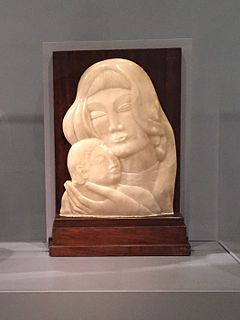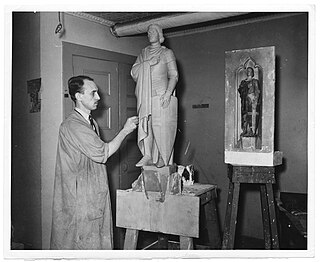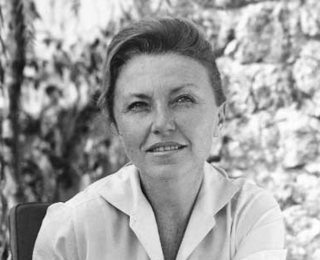
Daniel Chester French was an American sculptor of the late nineteenth and early twentieth centuries, best known for his design of the monumental statue of Abraham Lincoln (1920) in the Lincoln Memorial in Washington, D.C.

Gaston Lachaise was a French-born sculptor, active in the early 20th century. A native of Paris, he was most noted for his female nudes such as Standing Woman. Gaston Lachaise was taught the refinement of European sculpture while living in France. He met a young American woman, Isabel Dutaud Nagle, and the pair moved to America, where his craft reached maturity and he was influenced and inspired by American ways. Lachaise helped redefine the female nude in a new and powerful manner. His drawings also reflected his new style of the female form.

The Sheldon Museum of Art is an art museum in the city of Lincoln, in the state of Nebraska in the Midwestern United States. Its collection focuses on 19th- and 20th-century art.

Robert Laurent was a French-American modernist figurative sculptor, printmaker and teacher. His work, the New York Times wrote,"figured in the development of an American sculptural art that balanced nature and abstraction." Widely exhibited, he took part in the Whitney's 1946 exhibition Pioneers of Modern Art. Credited as the first American sculptor to adopt a "direct carving" sculpting style that was bolder and more abstract than the then traditional fine arts practice, which relied on models, Laurent's approach was inspired by the African carving and European avant-garde art he admired, while also echoing folk styles found both in the U.S. and among medieval stone cutters of his native Brittany. Best known for his virtuoso mastery of the figure, Laurent sculpted in multiple media, including wood, alabaster, bronze, marble and aluminum. His expertise earned him major commissions for public sculpture, most famously for the Goose Girl for New York City's Radio City Music Hall, as well as for Spanning the Continent for Philadelphia's Fairmount Park. After the Depression, he was also the recipient of several Works Progress Administration (WPA) Federal Art Project commissions under the New Deal, including a bas-relief called Shipping for the exterior of Washington, D.C.'s Federal Trade Commission Building, commissioned by the Treasury Department’s Section of Fine Arts in 1938.

Hans K. Schuler was a German-born American sculptor and monument maker. He was the first American sculptor ever to win the Salon Gold Medal. His works are in several important museum collections, and he also created many public monuments, mostly for locations in Baltimore, Maryland and in the Washington, D.C. area. For over a quarter of a century he served as president of the Maryland Institute College of Art.

The history of sculpture in the United States begins in the 1600s "with the modest efforts of craftsmen who adorned gravestones, Bible boxes, and various utilitarian objects with simple low-relief decorations." American sculpture in its many forms, genres and guises has continuously contributed to the cultural landscape of world art into the 21st century.

Richard Howard Hunt is one of the most important sculptors of the 20th century. In the second half of the 20th century, he became "the foremost African-American abstract sculptor and artist of public sculpture." Hunt, the descendant of enslaved people brought through the port of Savannah from West Africa, studied at the School of the Art Institute of Chicago in the 1950s, and while there received multiple prizes for his work. He was the first African American sculptor to have a retrospective at Museum of Modern Art in 1971. Hunt has created over 160 public sculpture commissions in prominent locations in 24 states across the United States, more than any other sculptor. With a career that spans seven decades, Hunt has held over 150 solo exhibitions and is represented in more than 100 public museums across the globe from California to Maine, Detroit to Birmingham, and Vienna to Jerusalem. Hunt has served on the Smithsonian Institution's National Board of Directors. Hunt's abstract, modern and contemporary sculpture work is notable for its presence in exhibitions and public displays as early as the 1950s, despite social pressures for the obstruction of African-American art at the time. Naomi Beckwith, Deputy Director and Jennifer and David Stockman Chief Curator of the Solomon R. Guggenheim Museum declared Richard Hunt "One of the most innovative artists of the Twentieth Century." President Barack Obama has stated "Richard Hunt is one of the greatest artists Chicago has ever produced."

Jean Tinguely was a Swiss sculptor best known for his kinetic art sculptural machines that extended the Dada tradition into the later part of the 20th century. Tinguely's art satirized automation and the technological overproduction of material goods.

John Raimondi is an American sculptor best known as a creator of monumental public sculpture, with works throughout the United States and several European countries. He lives and works in Palm Beach Gardens, Florida.

Baroque sculpture is the sculpture associated with the Baroque style of the period between the early 17th and mid 18th centuries. In Baroque sculpture, groups of figures assumed new importance, and there was a dynamic movement and energy of human forms—they spiralled around an empty central vortex, or reached outwards into the surrounding space. Baroque sculpture often had multiple ideal viewing angles, and reflected a general continuation of the Renaissance move away from the relief to sculpture created in the round, and designed to be placed in the middle of a large space—elaborate fountains such as Gian Lorenzo Bernini‘s Fontana dei Quattro Fiumi, or those in the Gardens of Versailles were a Baroque speciality. The Baroque style was perfectly suited to sculpture, with Bernini the dominating figure of the age in works such as The Ecstasy of St Theresa (1647–1652). Much Baroque sculpture added extra-sculptural elements, for example, concealed lighting, or water fountains, or fused sculpture and architecture to create a transformative experience for the viewer. Artists saw themselves as in the classical tradition, but admired Hellenistic and later Roman sculpture, rather than that of the more "Classical" periods as they are seen today.
James Edward Grant was an American painter and sculptor active from the late 1950s into the early 1970s. Best known for his sculptural work in plastics, this work by no means defined him, but was rather a natural endpoint of an exploration into increased dimensionality—starting from abstract canvases, moving through collages and bas-reliefs until the work finally came off the wall in sculptural form.

Albert Paley is an American modernist metal sculptor. Initially starting out as a jeweler, Paley has become one of the most distinguished and influential metalsmiths in the world. Within each of his works, three foundational elements stay true: the natural environment, the built environment, and the human presence. Paley is the first metal sculptor to have received the Lifetime Achievement Award from the American Institute of Architects. He lives and works in Rochester, New York with his wife, Frances.
Robert Neffson is an American painter known for his photorealistic street scenes of various cities around the world, museum interiors and for early still lifes and figure paintings.

Claes Oldenburg was a Swedish-born American sculptor, best known for his public art installations typically featuring large replicas of everyday objects. Another theme in his work is soft sculpture versions of everyday objects. Many of his works were made in collaboration with his wife, Coosje van Bruggen, who died in 2009; they had been married for 32 years. Oldenburg lived and worked in New York City.
Irving Sandler was an American art critic, art historian, and educator. He provided numerous first hand accounts of American art, beginning with abstract expressionism in the 1950s. He also managed the Tanager Gallery downtown and co-ordinated the New York Artists Club of the New York School from 1955 to its demise in 1962 as well as documenting numerous conversations at the Cedar Street Tavern and other art venues. Al Held named him, "Our Boswell of the New York scene," and Frank O'Hara immortalized him as the "balayeur des artistes" because of Sandler's constant presence and habit of taking notes at art world events. Sandler saw himself as an impartial observer of this period, as opposed to polemical advocates such as Clement Greenberg and Harold Rosenberg.

Roy Elwood King was an American born sculptor, painter and civil engineer.

Carla Lavatelli was an Italian-American artist whose career spanned five decades, from the 1950s into the early 2000s. Her work is in the permanent collections of several major museums, including the San Francisco Museum of Art, the Phillips Collection in Washington, D.C., the Hakone Open-Air Museum in Japan, and the Cantor Arts Center at Stanford University. She was noted primarily for her abstract sculptures in stone and bronze, which appeared in reproduction in such publications as Arts Magazine, Art in America, and Artforum during the late 1960s and early 1970s.
Frank Bernarducci is a New York City art dealer and curator. He is currently the owner of Bernarducci Gallery, located at 525 West 25th Street in New York, NY. Bernarducci began exhibiting Graffiti art in the 1980s in the East Village while director of Frank Bernarducci Gallery. Bernarducci continues to curate exhibitions featuring emerging and seasoned artists. His gallery is known for exhibiting realist and Photorealist art.

Tjalf Sparnaay is a Dutch artist, photographer, illustrator and painter.

Cheryl Kelley is an American painter known for her photorealism, especially her paintings of classic and muscle cars. Her work has been featured on the cover of Harper's Magazine and can be seen at the Scott Richards Contemporary Art gallery in San Francisco, California, the Bernarducci·Meisel Gallery in New York City, New York, and the Seven Bridges Foundation in Greenwich, Connecticut. In 2009 and 2011 she was a finalist for the Hunting Art Prize, and in 2012 she received a Pollock-Krasner Foundation grant. The art collectors' resource Artsy considers her one of ten "Masters of Photorealism".


















